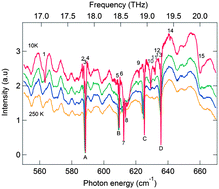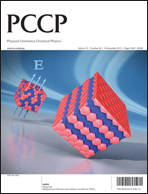Collective librations of water molecules in the crystal lattice of rubidium bromide: experiment and simulation†
Abstract
Terahertz spectroscopy of RbBr reveals four prominent absorption lines at room temperature and a further 15 lines at 10 K. Via density-functional-theory (DFT) numerical modelling using the PBE0 hybrid GGA functional, all the absorptions are identified as correlated librations of water molecules in the RbBr lattice. Each libration mode is a combination of rocking, wagging and twisting motions of the water molecules. The number of libration lines and numerical modelling show that the C2v symmetry of water in RbBr is broken. Our modelling shows that the distribution of libration amplitudes and phases for different water molecules in the RbBr unit cell varies greatly between the different modes. All librational lines red-shift with increasing temperature. The rate of change for most lines is in the range 60–90 MHz K−1 (or (2–3) × 10−3 cm−1 K−1). Two lines shift more rapidly with temperature, at rates of 240 and 300 MHz K−1 (or (8 and 10) × 10−3 cm−1 K−1), respectively. Furthermore, the temperature dependence of the linewidth distinguishes two groups of lines. For one group, with weak linear temperature dependence of linewidth, cubic anharmonic terms in the RbBr crystal field are significant. This group is mainly associated with fully symmetric correlated librations. For the second group, with strong non-linear temperature dependence of the linewidth, quartic anharmonic terms in the RbBr crystal field are significant. However, the distribution of libration amplitudes, as well as the type of libration modes, influence the temperature dependence of the red shift, the linewidth, and the intensity, as well. Our combined experimental and theoretical investigation confirms the necessity of obtaining low-temperature data to observe all the calculated modes; moreover, the richness of detail in the temperature dependence of the data invites further modelling spanning a range of temperatures.


 Please wait while we load your content...
Please wait while we load your content...